
views
List the steps to ride in an elevator.

Write down everything riding an elevator entails. This way, you’ll be able to systematically approach getting over your fear, step by step. For example, some of the steps you could write down include: Arriving at a new location to see that you must either ride an elevator or take the stairs. Pressing the “up” or “down” button and waiting for the elevator to arrive. Seeing how crowded the elevator is. Stepping into the elevator. Selecting your floor. Watching the door close and open.
Build a “fear ladder.”
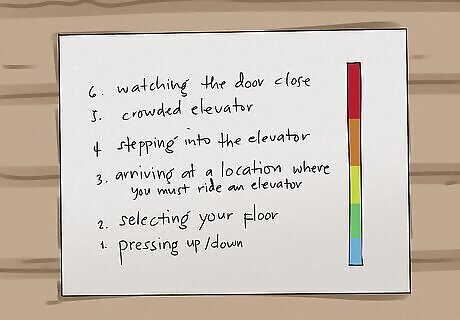
Rearrange the list based on how scared each step makes you. Order the steps from what frightens you the least to what frightens you the most. The goal is to start with a step that may make you slightly uncomfortable but that doesn’t intimidate you so that you can gradually expose yourself to your fear. For example, pressing the “up” or “down” button may not frighten you as much as waiting inside the elevator until you reach your floor, so put these steps in the appropriate order.
Practice the steps in the ladder.
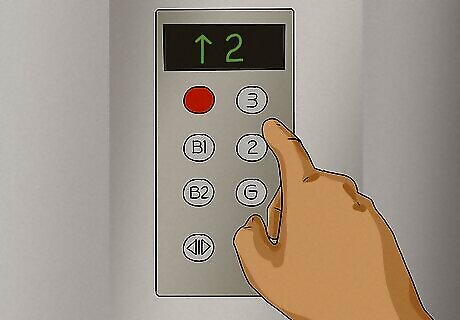
Progress from step to step gradually. When the step is relatively simple, like pressing the button for which floor you want to go to, repeat it often until you feel less anxious. If the step is longer, like waiting inside the elevator, stay in the situation long enough that your anxiety decreases. If you expose yourself to a situation for longer, you’ll feel less anxious the next time you face the challenge. The only thing not to do is to avoid your fear—avoidance will only reinforce the notion that you should be afraid of elevators. Stop if you feel overwhelmed or anxious. This is a sign that you should progress more slowly. Practice each step until you feel sufficiently comfortable with it to move on to the next. If you can, practice at a time when the elevator does not get a lot of use. It’s best to use an empty elevator so that you feel less anxious and don’t disrupt other people’s rides.
Make each step as manageable as possible.

Plan ahead to lessen your fear. Depending on what aspect of riding in an elevator scares you, you can plan ways to put your mind at ease ahead of time. If your fear is being enclosed in a small space with many people, and you know the elevator "rush hour" is at 8am and 5pm, practice at a time of the day when you know the elevator will be less crowded. If you worry about getting stuck in an elevator and having a panic attack, bring water and a snack with you when you practice. You can gradually stop bringing these comforting items as you get more familiar with riding in elevators.
Ask someone to ride with you.
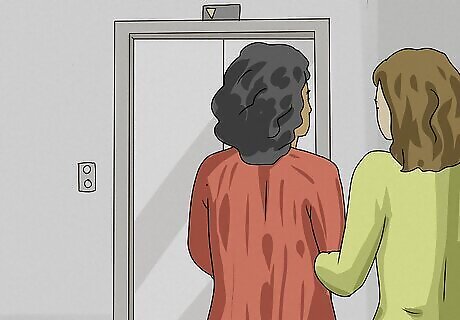
Having someone supportive may help you feel more comfortable. If you are too afraid to try stepping in an elevator alone, you can add another step to your gradual approach by asking a trusted friend to accompany you during your practices. As you feel more confident being inside an elevator over time, progress to riding on your own. A friend can also help you feel more at ease by conversing with you about a topic unrelated to the elevator ride.
Breathe deeply when you're anxious.

Breathing helps calm your nervous system. When you are anxious, you might hyperventilate, which will only add to the severity of the situation. Breathing slowly and calmly will reduce negative physical sensations associated with your fear. Try the following before and during your elevator rides: Stand straight with one hand on your chest and one hand on your stomach. Breathe in through your nose for 4 seconds. The hand on your stomach should rise and the hand on your chest should stay relatively still. Hold your breath for 7 seconds. Release the breath for a count of 8 seconds. As you push the air out, the hand on your stomach should slowly move in towards you. Repeat this process until you feel calm.
Be patient with yourself.
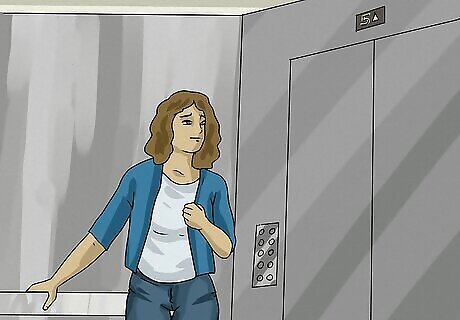
It can take time to overcome a fear. Becoming comfortable riding in an elevator might not happen all at once. Depending on the severity of your fear and on how often you practice getting used to riding in an elevator, it could take anywhere from a couple of weeks to months to get over your fear. That said, the more you practice, the faster you’ll get over your fear. Even when you get over your fear and are able to ride an elevator, you still may hesitate or feel slightly on edge. This is not unusual - if you have been afraid of elevators for a long time, it will take a while for feelings of nervousness to go away. You can work on making these feelings disappear by riding elevators more often.
Come up with positive coping statements.

Have a mantra to tell yourself when you're in an elevator. These are helpful when you are in a situation that makes you feel anxious, like being stuck in an elevator. Tell yourself something like “I’ve been in this situation before and have come out of it okay” or “Statistically, riding in an elevator is very safe. And if I do have a panic attack, I can wait for it to pass. Next time I practice, I will feel less anxious.”
Distract yourself.

Get your mind off the elevator. Focus on anything else during the ride. Try playing your favorite game on your phone, calling a friend (if there is service available), or counting backwards from 100 to 0.
Try riding different types of elevators.

Some types of elevators may make you less nervous. You may feel completely calm in an elevator with windows but become anxious in a windowless elevator. Consider this another step in your ladder to climb. Start out with the elevator with windows, then gradually try riding a windowless one. For example, riding an elevator with windows is a great starting point if what you're afraid of is being enclosed in a small space. When you start to feel claustrophobic, look out the window and breathe deeply. However, if your fear is caused by height rather than being in an enclosed space, it may be better to start by riding only in windowless elevators.
Learn the statistics.
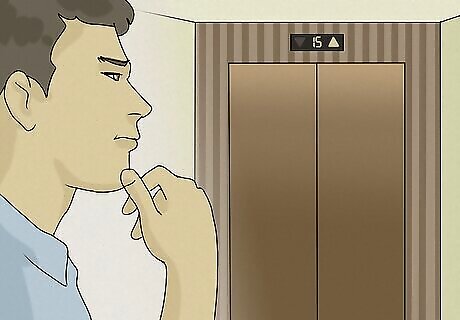
Riding an elevator is actually pretty safe. If your fear is rooted in the possibility of an accident taking place, know that elevator accidents do occur, but they are rare. In fact, the fatality rate has been calculated to be 0.00000015% per trip. Knowing the statistics can be reassuring. If you are anxious during your elevator ride, remind yourself that the probability of an accident occurring is very low. Poor maintenance and rider errors, such as attempting to get out of an elevator that’s stopped between 2 floors, are the 2 most frequent causes of elevator accidents. However, you can find comfort in the fact that all states require regular inspection and maintenance of elevators, and rider errors should not occur if you stay put during your ride.
Meditate for 5 minutes every day.

A daily meditation practice can help you overcome fears. Meditation allows your body to find a natural breathing rhythm, focus on the sensations of breathing in and out, and settle into an inner calm. Practice for 5 minutes every day in a non-stressful situation. After becoming familiar with meditation techniques, you can put them to use when you are feeling anxious inside an elevator.
Write down your anxious thoughts.

Journaling is a great way to overcome a fear. Thoughts related to fear are often unrealistic and unnecessarily negative. Seeing them laid out prior to stepping into the fearful situation can help you evaluate them and in turn reduce your concerns. For example, you may think: “The elevator will get stuck and I’ll have a panic attack.” Write this down, then ask yourself: do you have any evidence to suggest that this will be the case? Is there contradictory evidence that this will happen? For example, have you ever been in an elevator that has broken down before? Ask yourself what you would say to a friend with the same fear. You might tell them that the likelihood of this hypothetical coming true is low. Apply this reasoning to yourself and to your fear. If you have been in an elevator that got stuck before, remind yourself that the odds of this happening again are low.
Talk to a therapist if you need more help.

Take back your power with the help of a professional. If you fear is so debilitating that you behave uncharacteristically, such as by turning down job offers, avoiding visiting relatives or friends, or forcing yourself to climb stairs even when you shouldn’t, it may be time to see your doctor. Phobia sufferers may benefit from medication, therapy, or a combination of both. If you suffer from panic attacks related to riding in elevators, consider seeing a cognitive-behavioral therapist. They can work with you to understand your fear and gain coping skills.



















Comments
0 comment